| ... |
GemeindeView:
Boskovice
CURRENT CZECH NAME: Boskovice
OTHER NAMES/SPELLINGS:
Boscovice; Boskowitz (German name, as it was known before 1918)
LOCATION:
A town in the Drahanska Highlands of Moravia about 35 kms north of Brno,
near Prerov and Olomouc which also have former Jewish communities.
One can drive to Boskovice from Brno in about half an hour and the former
Jewish ghetto is well signposted. There is a small Jewish Museum at 6 Plackova
St in the middle of the fomer ghetto and many of the houses and the
synagogue have been, or are being, renovated and repaired.
(see
Map
- by Mapquest, then click
on your browser's "Back" button to return to this page).
HISTORY:
The first mention of a Jew in Boskovice was around 1343. Klenovsky
says in his booklet (The Boskovice Ghetto) that the Jews of Brno
went to Boskovice after they were banished from the Moravian Royal Towns
in 1454. At that time the Jews had restricted rights and paid high
premiums to be allowed to live in the town. But, by 1589, there were
148 Jews living in 25 family houses. In 1727 when the ghetto was set up
and the the first complete register written, the numbers had grown to 1531
Jews living in 38 family houses, 97 extensions and 40 cottages. Jews
in the 17th century worked as butcher, tailor, barber, purse maker,
goldsmith, red and white tanner, leather worker, sword blade maker, cabinet
maker, furrier, cap maker and others. In a real estate survey
of 1677, Jews owned nearly 23 hectares including arable land.
The town's memorial books mention fire and epidemics which affected both
Christians and Jews. In 1715 and the following year, a plague ravaged
the entire population and 200 Jews died.
Before the Josefinian reforms, Jews used mostly Hebrew/Yiddish or Czech
names - for example: Jakub Markus, Kalman, Israel, Pinkas, Lev Kain, Lebl
Salomon, Abraham, Nathan and, for women, Lida, Manda, Juettl, Resi, Nettl,
Friedl.
Further Jewish settlement was prohibited by the "Familianten "law
of Emperor Charles VI in the 1820's which allowed residence of only 326
Jewish families. Bransky's book includes the list of all male heads of
those families taken in the tax census of 1799. The first ten names in
the list are: Dawid Thorsch, Jakub Beamt, Dawid Schreiber, Salomon Friedmann,
Markus Friedmann, Abraham Lewue, Simon Husserl, Jakob Husserl, Dawid Eisner,
Feit Husserl.
At the turn of the 18th century there was an active yeshiva and by
the mid-19th century the Jewish population comprised one-third of all Boskovice
inhabitants.
The Jewish town had serious problems with fires, most likely due to overcrowding.
The worst one occurred in 1823, when practically two-thirds of the entire
town burned down.
The emancipation struggles in Europe culminated in 1848; by then, the Jews
benefited from a relaxation of restrictions dating to the Middle
Ages. By 1848, Jews were allowed to live where they wished.
The zenith of Jewish settlement recorded in Boskovice occurred in
1857 when the restrictive laws were repealed At that time, 1810 people
of the Hebrew faith lived in the town. Under the Josefinian laws,
Jews no longer had to wear special insignia on their clothing, but they
had to choose German names and German was decreed to be the official language
for Jews. To obtain permission to marry, a Jew had to pass a German
test.
The Boskovice Jewish Quarter was established as a separate political entity
with its own authorities, existing until 1919, just after the first Czechoslovakian
Republic was established. In the Second World War, only 14 of the 458 Boskovice
Jews survived a forced deportation to Terezin and other concentration camps.
Among those sent to Terezin were my grandfather's cousin Izidor THORSCH
and his wife Henrietta (nee BERGMANN).
Boskovice was one of the largest Jewish communities in Moravia and was
known as a centre of prominent Talmudist scholars. The most famous
of these scholars was Samuel ha-levi Kolin; he is buried in the local Jewish
cemetery.
In 1851, the Boskovice Rabbi Placek was appointed Chief Rabbi of Moravia
until 1884.
Boskovice Jews worked mainly in the restricted occupations of trade, commerce
and crafts but, in the 19th century, they began to establish industrial
production in Boskovice and other nearby Moravian towns. Families
who built up factories in Boskovice included Eisler, Czaczkes and Ticho,
and in other towns, Loew Beer, Popper and Biach.
In particular, the Jews founded the textile industry, with the Schwarz
family being most prominent. The Loew Beers established a woolen plant,
and Salomon Biach, Markus Ungar and Moritz Knopfelmacher started making
alcohol and liquers. Jews were especially well-recognized for founding
the fashion industry in machine-equipped factories. The Ticho brothers
and Sigmund Munk were successful producers of ready-made clothing.
After the first Zionist groups began at the turn of the 20th century,
the 1930's saw the start of migration to Palestine.
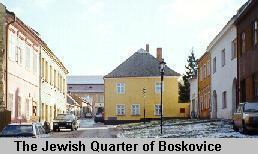 The Jewish Quarter that remains today is a vast complex between
The Jewish Quarter that remains today is a vast complex between 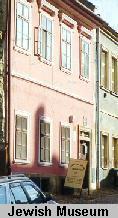 the
castle area and the historical core, encompassing 5 hectares, 13
streets and 79 preserved houses (of the original 138). More than
25 of the existing and remaining Jewish buildings have been declared national
monuments and so are protected by the State. Remaining sites of interest
include a school at 7 Bilkova street, a spa at u Koupadel 8, a hospital
ve Spitalku 10, a rabbinate at Plackova St 45, a mikvah in the house at
Zborovska St 9, the ghetto gate and a fountain from 1875. In the house
at Plackova St no 6 is a small museum with exhibits of the history and
memories of the Jewish community, open from 10 A.M. to 4.30 P.M. daily
except Mondays. the
castle area and the historical core, encompassing 5 hectares, 13
streets and 79 preserved houses (of the original 138). More than
25 of the existing and remaining Jewish buildings have been declared national
monuments and so are protected by the State. Remaining sites of interest
include a school at 7 Bilkova street, a spa at u Koupadel 8, a hospital
ve Spitalku 10, a rabbinate at Plackova St 45, a mikvah in the house at
Zborovska St 9, the ghetto gate and a fountain from 1875. In the house
at Plackova St no 6 is a small museum with exhibits of the history and
memories of the Jewish community, open from 10 A.M. to 4.30 P.M. daily
except Mondays.
GENEALOGICAL RESOURCES:
The town information center has copies, in English, of a pamphlet written
by local historian Dr Jan Bransky, "The Boskovice Jewish Ghetto
Sights." It locates and describes nearly 30 houses, the synagogue,
the mikvah, the hospice, yeshivah, the butcher shops and some of
the history of the thousands of Jewish families who lived and worked in
these buildings.
Archival
records for Boskovice:
In the State Archives in Prague the following registers are held by Dr
Lenka Matusikova for Boskovice. They are known in Czech as Zidovske Matriky
and their catalogue identification is HBMa.
|
Births:
|
1823-1832
1832-1848
1925-1949
1946-1948 |
Register no.:
|
100
101
106
107 |
.. |
.. |
|
Marriages:
|
1823-33
1832-48
1925-40;42-49 |
|
102
103
106 |
.. |
.. |
|
Deaths:
|
1823-32
1832-48
1925-33; 39-49
1945-48 |
|
104
105
106
107 |
.. |
.. |
Note
that in Czech the word for birth is denoted by "R" (czech -rodin), for
marriages by "O" (czech- oddovkova) and deaths by "Z" (czech-zatracemi),
so that's how the register describes each section.
Some of the registers have an index at the back, for others one must
look at every entry. For Boskovice, many of the registers were destroyed
either by fire or during World War II.
NOTABLE RESIDENTS AND DESCENDANTS:
Boskovice is the native town of the oculist Abraham Albert Ticho (1883-1960
Jerusalem) and of the writer Hermann Ungar (1893-1929 Prague). Ungar was
one of the Prague circle of writers associated with Franz Kafka.
SYNAGOGUES:
The synagogue on Traplova St., built in 1698 in Baroque style, displays
adaptations in empire and neo-gothic styles. In 1705, Jeshaya Maler
and Loeb from Krakow painted the interior walls with Hebrew liturgical
texts. Up to the 1990's, the synagogue was used as a storehouse but, in
199, restoration began. There were two other synagogues in Boskovice, a
smaller one built in the 18th century and the Loew Beer's synagogue in
1884. Both were destroyed after WW II.
It is hoped with the renovation of this last existing synagogue to establish
an exhibition of Jewish life in Boskovice. If one wishes to contribute
to the renovation, please contact the submitter
of this article for more information. The Maisel Synagogue in Prague
has as part of its permanent exhibition a lot of information and many
liturgical objects from Boskovice and Moravia. It's well worth a visit.
CEMETERIES:
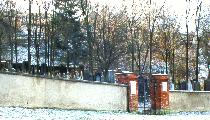
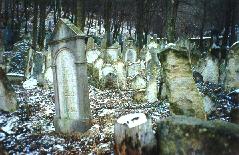
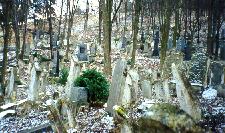
|
The Jewish cemetery, claimed by Dr. Bransky to be the third largest Jewish
cemetery in today's Czech Republic, is about 800 metres (southwest
of the town) down the end of Plackova Street on a hillside with the intriguing
name of 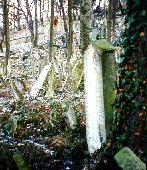 "Scheissberg,"
colloquially known as "the mountain of shit." We entered with a key Dr.
Bransky arranged via the Information Centre. The 2500 tombstones are in
reasonable condition, some better than others. Many of the older sandstone
tombstones are crumbling. Some gravestones have fallen over and some have
been desecrated by vandals. The later marble gravestones in are in quite
good condition, although the ivy and other vegetation is now spreading
across the entire hillside. About 12,000 people are buried in this cemetery. "Scheissberg,"
colloquially known as "the mountain of shit." We entered with a key Dr.
Bransky arranged via the Information Centre. The 2500 tombstones are in
reasonable condition, some better than others. Many of the older sandstone
tombstones are crumbling. Some gravestones have fallen over and some have
been desecrated by vandals. The later marble gravestones in are in quite
good condition, although the ivy and other vegetation is now spreading
across the entire hillside. About 12,000 people are buried in this cemetery.
The local town authorities have given priority to repairing the synagogue,
so the cemetery remains under threat of further deterioration in future.
No manager exists and there is no plan of the cemetery available either.
There are no existing cemetery records for Boskovice in the Jewish Museum
in Prague. Some of the death records are listed in the registers
held at the Prague State Archives. See above
for more details. |
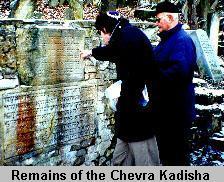 The cemetery on Potocni St. was founded no later than the 16th century
on an area of 14,528 sq. m., with the oldest existing grave dating
to 1670. The ruins of a Chevra Khaddisha are in the middle of the
cemetery, with the Kaddish inscription and the dedication stone still remaining.
The cemetery on Potocni St. was founded no later than the 16th century
on an area of 14,528 sq. m., with the oldest existing grave dating
to 1670. The ruins of a Chevra Khaddisha are in the middle of the
cemetery, with the Kaddish inscription and the dedication stone still remaining.
CONTACTS:
SOURCES:
- Bransky, J., The
Boskovice Jewish Ghetto Sights, Friends of Boskovice Club, 1999
- Bransky, J., Zide
v Boskovicich. Klub Pratel Boskovic, Nakladatelstvi Albert, Boskovice,
1999. One chapter - summary in English translated by Henry Wellisch
- Klenovsky, J., Jewish
Monuments in Moravia and Silesia, Sponsored by Zurich Insurance, Milesovska
5, 130 00 Prague 3.
- Klenovsky, J., Zidovska
ctrvrt v Boskovicich, Boskovice 1994.
- Mokotoff, G., Sach,
S.A., Where Once We Walked, Avotaynu, NJ, 1991
- Mokotoff G., "How
to document victims" 1995, Holocaust Museum, Washington
- Listing of Jews deported
from Boskovice, Holocaust Museum, Washington
- Encyclopedia Judaica.
SUBMITTER: Daniela
Torsh
Return to GemeindeView Home
Return to Austria-Czech SIG Homepage
Home
|
... |



